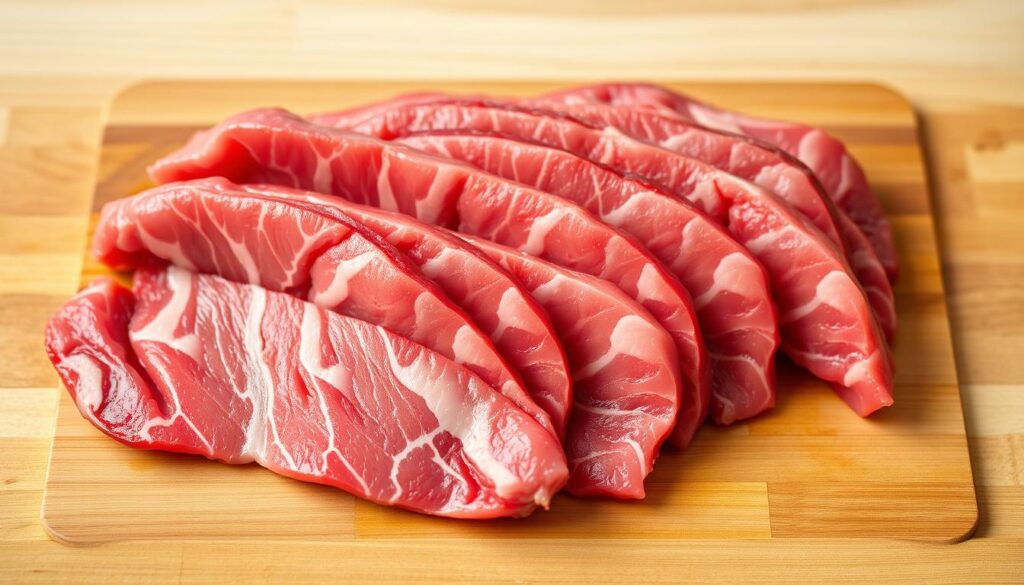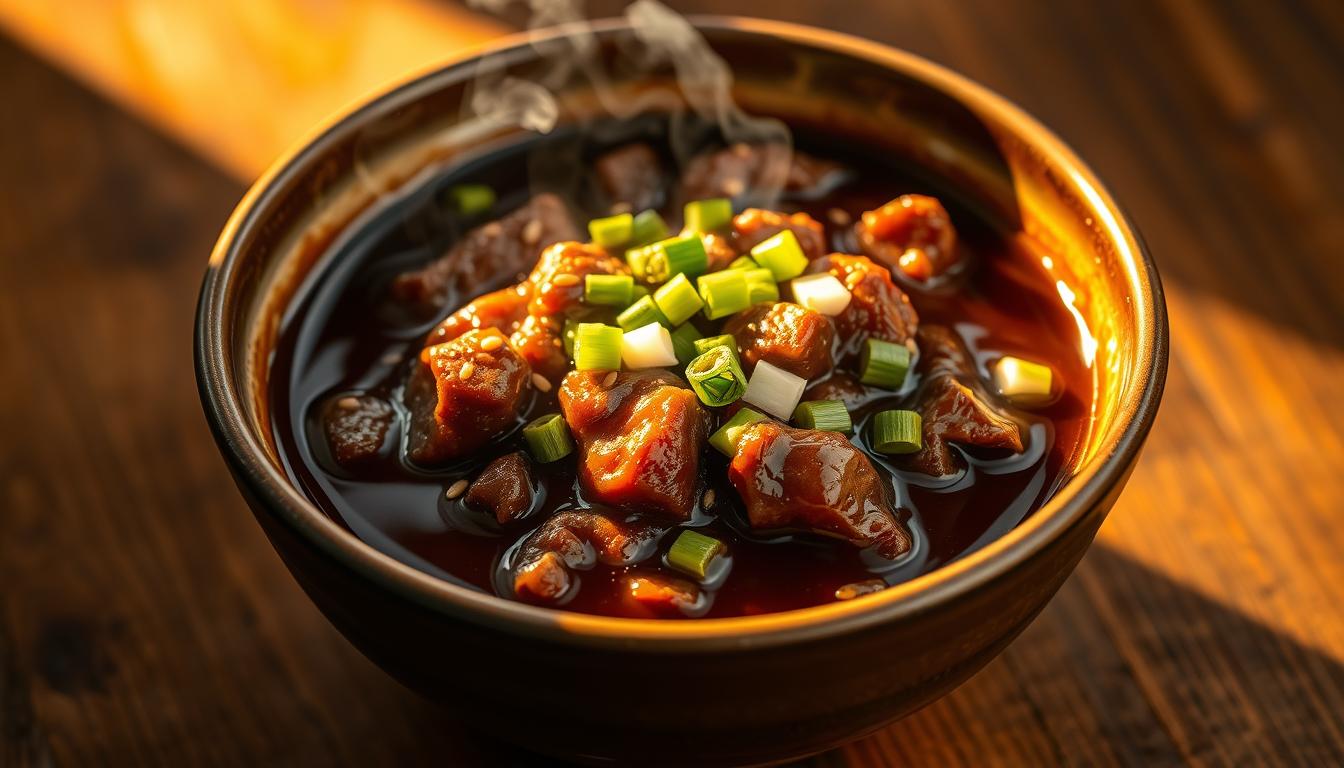Imagine a dish that combines the bold, sweet, tangy, and savory flavors of Korea. Beef bulgogi sauce is a culinary masterpiece that brings these elements together in perfect harmony. Whether you’re a seasoned chef or a kitchen newbie, this sauce is your gateway to creating authentic, mouthwatering meals with minimal effort.
At its core, bulgogi sauce is a fusion of traditional Korean ingredients like soy sauce, garlic, ginger, and sugar. This blend creates a rich, flavorful base that’s perfect for marinating beef or as a dipping sauce. The best part? It’s incredibly versatile, allowing you to customize it to your taste preferences.
Ready to elevate your meals? Let’s dive into this easy-to-follow guide and unlock the secrets of making authentic bulgogi sauce at home. Your taste buds will thank you!
Introduction to Korean Bulgogi and Its Sauce
Korean cuisine is a vibrant tapestry of flavors, and at the heart of this culinary tradition lies the beloved dish known as bulgogi. This iconic recipe has captivated taste buds worldwide with its harmonious blend of sweet, savory, and smoky elements.
Discovering the Rich History and Culture
Bulgogi traces its roots back to the Goguryeo era, where it was served as a luxury dish for royalty. The term “bulgogi” literally means “fire meat,” reflecting its traditional cooking method over an open flame. Over time, the sauce evolved, incorporating ingredients like soy sauce, garlic, and ginger, creating the distinctive marinade we know today.
How Korean BBQ Inspires Your Cooking
Modern Korean BBQ has popularized bulgogi worldwide, introducing its rich flavors to global audiences. The sauce serves as both a marinade and a dipping sauce, offering unparalleled versatility. Its popularity has been further amplified by social media, with countless food enthusiasts sharing their bulgogi creations.
| Aspect | Traditional | Modern |
|---|---|---|
| Ingredients | Soy sauce, garlic, ginger | Added sugar, sesame oil |
| Cooking Method | Grilled over wood | Grill pans, electric grills |
| Popularity | Regional dish | Global phenomenon |
“The essence of Korean BBQ lies in its ability to bring people together, sharing flavors that transcend borders and cultures.”
By embracing the rich history and cultural depth of bulgogi, you can infuse your cooking with authentic Korean flavors, creating memorable dishes that delight both family and friends.
What is Beef Bulgogi Sauce?
Beef bulgogi sauce is a cornerstone of Korean cuisine, offering a rich tapestry of flavors that captivate the senses. It’s a masterful blend of sweet, tangy, and savory notes, creating a harmonious balance that enhances any dish it touches.
Flavor Profile and Traditional Significance
The sauce is traditionally made with ingredients like soy sauce, sugar, ginger, and garlic. These components come together to create a flavor profile that’s both aromatic and deep. The sweetness often comes from sugar or fruits like pears, while the tanginess is typically from soy sauce. Ginger and garlic add a pungent yet balanced aroma, making the sauce versatile for marinating, dipping, or even stir-frying.
Store-Bought vs. Homemade Benefits
While store-bought options offer convenience, homemade beef bulgogi sauce ensures authenticity and freshness. Making it from scratch allows you to control the ingredients, preserving the traditional taste. Plus, you can customize it to suit your preferences, whether that means adjusting the sweetness or adding a bit more ginger for extra zing.
Homemade sauce also avoids the preservatives found in many commercial products, giving you a cleaner and more natural flavor. This makes it ideal for those looking to experience the authentic essence of Korean cuisine without compromise.
Essential Ingredients for Your Bulgogi Sauce
Creating an authentic bulgogi sauce starts with selecting the right ingredients. Each component plays a vital role in achieving that perfect balance of flavors.
Key Components: Soy Sauce, Gochujang, and Sesame Oil
Soy sauce is the backbone of bulgogi sauce, providing a rich, savory foundation. Look for a high-quality soy sauce to ensure depth of flavor. Gochujang, a Korean chili paste, adds a bold, slightly sweet heat that enhances the sauce’s complexity. Sesame oil, with its distinct nutty aroma, is used sparingly to add depth without overpowering the other ingredients.
The Secret Role of Pear or Apple in Tenderizing
Grated pear or apple serves as a natural tenderizer, breaking down proteins to create a tender texture. Pears are preferred for their subtle sweetness, while apples add a slight tartness. This secret ingredient not only softens the meat but also infuses a fruity sweetness into the sauce.
| Ingredient | Role |
|---|---|
| Soy Sauce | Provides savory depth |
| Gochujang | Adds spicy, sweet notes |
| Sesame Oil | Enhances aroma and depth |
| Pear or Apple | Tenderizes and adds sweetness |
Brown sugar balances the savory elements, while fresh garlic and ginger add aromatic complexity. These ingredients harmonize to create a sauce that’s both flavorful and versatile.
Step-by-Step Guide to Crafting Your Sauce
Creating a delicious marinade from scratch is simpler than you think. With a few simple steps, you can craft a flavorful recipe that elevates your dishes to the next level.
Mixing the Base Ingredients
Start by combining the essential components in a bowl. Add soy sauce for depth, followed by minced garlic and grated ginger for aromatic complexity. These elements form the foundation of your marinade.
- In a bowl, whisk together soy sauce, garlic, and ginger until smooth.
- Gradually add sugar, stirring until dissolved for a balanced flavor.
Incorporating the Special Additions
Enhance your batch by adding special touches. A spoonful of gochujang adds heat, while a drizzle of sesame oil brings a nutty aroma. For sweetness, include grated pear or apple.
- Mix in gochujang and sesame oil for added depth.
- Stir in grated pear or apple to infuse natural sweetness.
Preparing the marinade fresh ensures vibrant flavors. This approach avoids preservatives found in store-bought options, offering a cleaner taste. Plus, it allows you to customize the recipe to your liking, whether that means more ginger or a touch less sugar.
By following these steps, you can create a marinade that’s both authentic and adaptable, perfect for any dish you desire.
Achieving the Perfect Marinade Consistency
Creating a smooth marinade is key to ensuring your dish turns out flavorful and tender. The right consistency makes all the difference, and it all starts with proper whisking techniques.
Whisking Techniques for a Smooth Texture
Whisking is more than just mixing ingredients. It’s about creating an emulsified blend that coats evenly. Start by whisking your marinade in a steady, circular motion. This helps break down solids and incorporates liquids seamlessly. Avoid over-whisking, as it can create air pockets that lead to a frothy texture.
When heating your marinade, use a pan over medium heat. A good pan distributes heat evenly, preventing hotspots that can burn the mixture. Stir occasionally to ensure uniform thickening. Remember, the goal is a smooth, velvety texture that clings well to your meat.
Common Mistakes to Avoid
One common mistake is using too high heat, which can cause the marinade to thicken unevenly. Instead, maintain a moderate temperature and whisk constantly. Also, avoid using a thin pan, as it doesn’t retain heat well. Opt for a sturdy pan that allows for consistent cooking.
Another tip is to let the marinade rest after whisking. This allows flavors to meld and the texture to stabilize. When you’re ready to use it, give it a quick whisk to ensure everything is well incorporated.
By following these techniques, you’ll achieve a marinade that coats your meat evenly, ensuring optimal flavor absorption. The right consistency and texture make all the difference in creating a dish that’s both delicious and visually appealing.
Selecting the Best Beef for Bulgogi
Choosing the right cut of meat is crucial for achieving tender and flavorful bulgogi. Whether you’re a novice or an experienced cook, selecting the appropriate beef cut can make a significant difference in the final dish.
Tender Cuts and Regional Variations
For bulgogi, ribeye and sirloin are popular choices due to their tenderness and rich flavor. These cuts absorb the marinade exceptionally well, ensuring a juicy and delicious outcome. Additionally, flank steak is another excellent option for those who prefer a leaner cut, though it may require slightly longer marinating time.
Regional variations in beef selection can also influence the flavor profile. In some areas, local butchers may recommend specific cuts that have been traditionally used for korean bbq, offering a unique taste experience. Understanding these regional preferences can help you make informed decisions when selecting your meat.
How to Slice Meat for Maximum Tenderness
To achieve the best results, always slice the meat thinly across the grain. This technique ensures even cooking and prevents the meat from becoming tough. Use a sharp knife and slice when the meat is slightly frozen, as this makes it easier to handle and results in uniform slices.
Optimal Grill Techniques
When grilling, preheat your grill to medium-high heat to achieve a nice sear. Cook the slices for about 3-5 minutes per side, depending on the thickness. Avoid overcrowding the grill to ensure each piece cooks evenly. This method preserves the meat’s tenderness and enhances the overall flavor.

By selecting the right cut and following proper slicing and grilling techniques, you can elevate your bulgogi dish to new heights. Experiment with different cuts and regional variations to find your perfect combination.
Marinating Your Meat to Maximize Flavor
Marinating your meat is a crucial step that can elevate the flavor of your dish. Understanding how long to marinate and why timing matters is essential for achieving the best results.
How Long to Marinate and Why Timing Matters
The marination time depends on the type of meat you’re using. For tender cuts like ribeye or sirloin, a shorter marination time of 30 minutes to 2 hours is sufficient. This allows the flavors to infuse without overpowering the natural taste of the meat.
For tougher cuts, like flank steak, a longer marination time of 6 to 24 hours is recommended. This extended time helps break down the proteins, making the meat more tender and flavorful. The key is to find the right balance—too short, and the flavors won’t penetrate; too long, and the meat might become mushy.
The science behind marination lies in how ingredients like ginger interact with meat proteins. Ginger contains enzymes that break down these proteins, tenderizing the meat. However, over-marinating can lead to an unpleasant texture, so it’s important to monitor the time closely.
| Marination Time | Benefits |
|---|---|
| 30 minutes to 2 hours | Ideal for tender cuts; flavors infuse without overpowering the meat. |
| 6 to 24 hours | Suitable for tougher cuts; breaks down proteins for tenderness and flavor. |
Here’s a tip: Always marinate in the refrigerator, not at room temperature, to ensure food safety. Turn the meat halfway through the marination time for even flavor distribution. Consistency is key, so stick to your chosen time frame for the best results.
By following these guidelines, you can maximize the flavor potential of your meat, ensuring a delicious and memorable dining experience.
Cooking Techniques: Grilling vs. Pan Frying
When it comes to cooking your bulgogi, the method you choose can make a big difference in flavor and texture. Grilling and pan-frying are two popular techniques, each with its own set of benefits and drawbacks. Let’s explore how these methods can enhance your dish.
Comparing Flavor Profiles and Textures
Grilling adds a smoky, charred flavor that many find irresistible. It’s perfect for creating a caramelized crust on your meat, which locks in juices and enhances tenderness. On the other hand, pan-frying offers a more controlled environment, allowing for even searing and a crispy texture. Both methods can produce delicious results, but the choice depends on the texture you prefer.
Heat Considerations and Cooking Tips
High heat is essential for achieving a perfect sear, whether you’re using a grill or a skillet. For grilling, preheat to medium-high heat and ensure the grates are clean to prevent sticking. When pan-frying, a well-seasoned cast iron skillet is ideal. Add a small amount of oil to the pan and let it heat up before adding your meat. This helps create a nice crust without burning the oil.
For chicken and pork alternatives, pan-frying is often preferred as it allows for better control over cooking temperatures. However, grilling can still yield great results if done correctly. Remember to pat the meat dry before cooking to ensure the oil adheres properly and creates that golden-brown crust.
Experiment with both methods to see which one you enjoy more. Each technique brings out unique qualities in your dish, making every meal a new culinary adventure.
Enhancing Your Dish with Creative Add-Ins
Elevate your meal with fresh vegetables and aromatic ingredients. Adding these elements can transform your dish into a vibrant and flavorful experience.
Incorporating Vegetables and Aromatics
Onions and green onions are excellent additions to your dish. Onions add a sweet crunch, while green onions provide a fresh, vibrant color. Sautéed onions can caramelize, creating a sweet contrast to the savory meat, while green onions add a crisp texture and a pop of color to your plate.
Pair your meal with complementary side dishes for a well-rounded experience. A fresh salad or pickled vegetables can balance the richness of the meat. These sides add variety and texture, making every bite more enjoyable.
For a creative touch, drizzle extra dipping sauce over your dish and sprinkle toasted sesame seeds. These add-ins enhance the flavor and presentation. To balance the seasoning, add a touch more garlic for a well-rounded taste.

Serving Suggestions for an Authentic Experience
Presentation is the final touch that elevates your meal from delicious to memorable. A well-arranged dish can enhance the dining experience, making it both visually appealing and flavorful.
Presentation Ideas and Side Pairings
Start by considering the visual appeal of your dish. A beautifully arranged plate can make your meal more inviting. Here are some tips to help you present your dish like a pro:
- Use a shallow bowl to showcase your dish attractively. A bowl helps contain the ingredients neatly while adding a modern touch to your presentation.
- Add fresh garnishes like green onions, toasted sesame seeds, or a sprinkle of crispy garlic to add color and texture to your dish.
- Pair your meal with complementary side dishes. A fresh salad or pickled vegetables can balance the richness of the meat, offering a refreshing contrast.
| Side Dish | Pairing Reason |
|---|---|
| Fresh Salad | Provides a light, refreshing contrast to the savory meat. |
| Pickled Vegetables | Offers a tangy crunch that complements the dish’s flavors. |
| Steamed Rice | Serves as a neutral base to soak up the flavorful sauce. |
For an extra touch, drizzle a light, sugar-based dipping sauce over your dish. This adds a subtle sweetness that enhances the overall flavor profile. Remember, the key to a great presentation is balance—ensure each element on the plate complements the others without overwhelming the senses.
Finally, don’t forget to share your creations with others. There’s joy in seeing your hard work bring people together around the table. Thanks for taking the time to craft an authentic experience, and I hope you enjoy every bite!
Variations and Expert Tips for Perfect Beef Bulgogi Sauce
Elevate your dish with expert tips and creative variations. Whether you prefer it sweeter or spicier, these insider secrets will help you craft a marinade that suits your taste perfectly.
Adjusting Heat and Sweetness to Suit Your Taste
Customize your batch by tweaking the heat and sweetness. Start with a base recipe, then adjust to your liking. For a spicier flavor, add more pepper. If you prefer it sweeter, add a touch more sugar.
- Add extra seeds like sesame or poppy for depth and texture.
- Use a pinching method to add spices gradually, ensuring a balanced flavor.
Experiment with different ratios of ingredients while maintaining traditional authenticity. Each batch can be unique, tailored to your preferences.
Remember, the key to a great marinade is balance. Adjust, taste, and refine until it’s just right for you.
Conclusion
With these simple steps, you can craft an authentic Korean BBQ dish that impresses. Making your own sauce allows you to control every flavor, ensuring each pound of meat is seasoned to perfection. For storage, keep any leftover sauce in an airtight container in the fridge for up to a week.
Don’t hesitate to experiment with different ingredients and techniques. Whether it’s adjusting the heat or adding a touch more soy, the key is to make the recipe your own. Share your creations with friends and family—after all, the joy of cooking lies in bringing people together.
Remember, a little extra oil and soy can elevate your dish from good to great. Happy cooking, and enjoy the delicious journey into Korean cuisine!
FAQ
How long should I marinate the meat for the best flavor?
Can I use a skillet instead of a grill for cooking?
What is the purpose of adding pear or apple to the marinade?
How do I store homemade bulgogi sauce?
Can I adjust the level of spiciness in the sauce?
What cut of beef is best for bulgogi?
Can I use this marinade for chicken or pork?
Why is sesame oil important in the recipe?
How do I prevent the meat from burning when grilling?
Can I make the sauce sweeter?
What are the best sides to serve with bulgogi?

